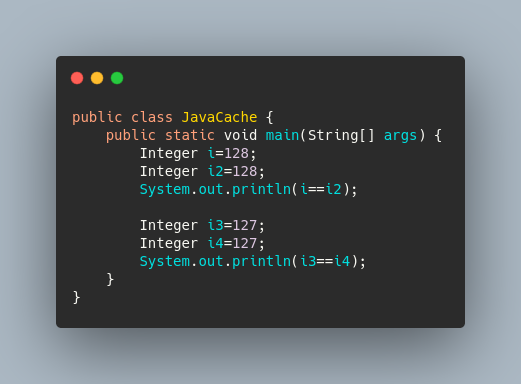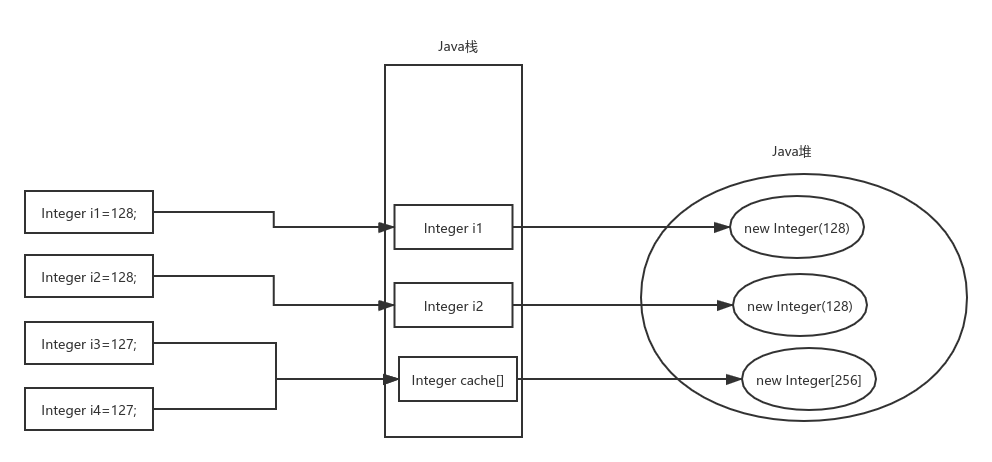Java包装类缓存机制
面试题
首先,来看一道常见的面试题,下面代码运行后会输出什么?

上面代码运行后,最终会输出false和true;为什么会这样呢?
按道理来说,在Java中==是比较两个对象的地址,上面代码中i3和i4是两个不同的对象,理应也应该返回是false,怎么返回是true呢?让我们慢慢往下看
Integer的缓存机制
让我们来看看他的源代码.
当执行Integer i=128;这个语句时,Java会调用valueOf(int i)方法,然后自动装箱的方式,让其变成Integer i=new Integer(128),具体源码如下:
public static Integer valueOf(int i) {
if (i >= IntegerCache.low && i <= IntegerCache.high)
return IntegerCache.cache[i + (-IntegerCache.low)];
//装箱
return new Integer(i);
}
从上面的源码中可以看到,在装箱之前会执行一个if语句,这个if语句就是判断传入的值是否在缓存内,如果在缓存内,就直接返回缓存内的值,如果不在缓存内,就装箱,在堆内创建一个新空间来存放.
//Integer包装类缓存源码
private static class IntegerCache {
static final int low = -128;
static final int high;
static final Integer cache[];
static {
// high value may be configured by property
int h = 127;
String integerCacheHighPropValue =
sun.misc.VM.getSavedProperty("java.lang.Integer.IntegerCache.high");
if (integerCacheHighPropValue != null) {
try {
int i = parseInt(integerCacheHighPropValue);
i = Math.max(i, 127);
// Maximum array size is Integer.MAX_VALUE
h = Math.min(i, Integer.MAX_VALUE - (-low) -1);
} catch( NumberFormatException nfe) {
// If the property cannot be parsed into an int, ignore it.
}
}
high = h;
cache = new Integer[(high - low) + 1];
int j = low;
for(int k = 0; k < cache.length; k++)
cache[k] = new Integer(j++);
// range [-128, 127] must be interned (JLS7 5.1.7)
assert IntegerCache.high >= 127;
}
private IntegerCache() {}
}
从源码中可以看到,Integer的缓存范围是-128~127,所以过程大致如下:

按照上面这个方法,只要在数据在缓存池范围内的,都会引用缓存在堆内的地址,所有上面的i3==i4会输出为true;而不在缓存范围内的,就会在堆中开放新的空间来存放对象,所以地址不同,用==比较返回也不同;
其他包装类缓存机制
除了Integer之外,其他的包装类也使用了缓存技术;
Long
缓存范围-128~127
public static Long valueOf(long l) {
final int offset = 128;
if (l >= -128 && l <= 127) { // will cache
return LongCache.cache[(int)l + offset];
}
return new Long(l);
}
private static class LongCache {
private LongCache(){}
static final Long cache[] = new Long[-(-128) + 127 + 1];
static {
for(int i = 0; i < cache.length; i++)
cache[i] = new Long(i - 128);
}
}
Byte
缓存范围-128~127 (byte范围:一个byte占8位,所以取值范围是**-2^7~2^7-1**)
public static Byte valueOf(byte b) {
final int offset = 128;
return ByteCache.cache[(int)b + offset];
}
private static class ByteCache {
private ByteCache(){}
static final Byte cache[] = new Byte[-(-128) + 127 + 1];
static {
for(int i = 0; i < cache.length; i++)
cache[i] = new Byte((byte)(i - 128));
}
}
Character
缓存范围0~127 (ascii码范围)
public static Character valueOf(char c) {
if (c <= 127) { // must cache
return CharacterCache.cache[(int)c];
}
return new Character(c);
}
private static class CharacterCache {
private CharacterCache(){}
static final Character cache[] = new Character[127 + 1];
static {
for (int i = 0; i < cache.length; i++)
cache[i] = new Character((char)i);
}
}
Short
缓存范围-128~127
public static Short valueOf(short s) {
final int offset = 128;
int sAsInt = s;
if (sAsInt >= -128 && sAsInt <= 127) { // must cache
return ShortCache.cache[sAsInt + offset];
}
return new Short(s);
}
private static class ShortCache {
private ShortCache(){}
static final Short cache[] = new Short[-(-128) + 127 + 1];
static {
for(int i = 0; i < cache.length; i++)
cache[i] = new Short((short)(i - 128));
}
}
Boolean
缓存范围
truefalse它只设置了两个静态变量用来充当缓存
public static final Boolean TRUE = new Boolean(true);
public static final Boolean FALSE = new Boolean(false);
public static Boolean valueOf(boolean b) {
return (b ? TRUE : FALSE);
}
建议
包装类对比数据是否相同的时候,建议采用重写的equals()方法.